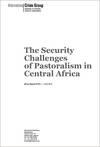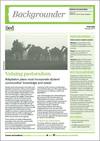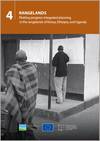Although Ethiopia has seen dramatic increases in formal exports, it is less recognised that pastoralist areas supply most of the animals for export. For this supply to be maintained or increased, specific livestock policy support is needed based on consultation with pastoralists, traders and other private sector actors, along with stronger coordination of the government ministries that oversee different aspects of the production and trade system.
This policy brief presents a brief overview of the eco-political landscape of livestock trade, lessons learnt from livestock and trade programmes, and policy priorities for supporting pastoral livestock marketing.
Year of publication: 2014
Organization:
Topic: Économie, Peuples autochtones, Participation, Value addition
Language: English
Type of document: Technique
Geographical coverage: Afrique orientale
Into the fold: What pastoral responses to crisis tell us about the future of pastoralism in the Horn
More than ever before, pastoral areas of the Horn of Africa are coming into the fold of wider economic processes. Expropriations of land and key resources in rangelands for the establishment of private ranches and commercial farms, the expansion of roads, telecommunications, and marketing facilities to promote trade and mobility, and investments in hydrocarbons are some of the ways that pastoral areas are being newly encapsulated into regional and global capitalist development.
This paper is concerned with how pastoral livelihoods are likely to evolve in areas of the Horn of Africa where processes of incorporation are intensifying. It reports the findings of a survey of 110 Maasai households in seven sites in Laikipia on pastoral livelihoods and strategies to manage and recover from the severe drought crisis of 2008-2010.
Year of publication: 2014Organization:
Topic: Changement climatique, Économie, Sécurité alimentaire, Peuples autochtones, Régime foncier, Résilience, Services sociaux, Value addition
Language: English
Type of document: Technique
Geographical coverage: Afrique orientale
In the last few years, conflicts between pastoralists and local communities have intensified because of a combination of factors: worsening security; climate change; the multiplication of migration roads, especially transnational routes; the expansion of cultivated areas and an increase in cattle herds. The report looks at three countries – Chad, Central African Republic and Democratic Republic of Congo – and explores various approaches of managing pastoral conflict and regulate transhumance.
Year of publication: 2014Organization:
Topic: Conflit
Language: English, Français
Type of document: Technique
Geographical coverage: Afrique centrale
More than just a means of production, pastoralism is a way of life intrinsically linked to the identity of the individuals and communities that practise it. Given their traditionally nomadic lifestyle, the fact that pastoralists can become internally displaced is often overlooked. Some even question whether it can happen at all.
This study focuses on northern Kenya. It argues that their internal displacement is a reality that has to be understood within a broader discourse about mobility, and creates a conceptual understanding of the phenomenon by examining its multi-causality. In doing so, it also discusses processes and options for improving protection and assistance for those affected. Pastoralists’ internal displacement is presented as a process of impoverishment and decreasing resilience, which leads to the disenfranchisement of rights, marginalisation and neglect. As such, it is as much a human rights as a humanitarian and development concern that requires a holistic approach.
Year of publication: 2014Organization:
Topic: Changement climatique, Conflit, Régime foncier, Résilience
Language: English
Type of document: Technique
Geographical coverage: Afrique orientale
This two-page document summarizes IIED’s position and work on pastoralism. Policymakers have ignored the wealth of experience and expertise of pastoralists with negative consequences. In the face of climate change and increasing uncertainty in drylands, the need to reframe policy and practice has never been greater. The future must be built on sound scientific information, local knowledge, informed participation and the wisdom of local institutions.
Year of publication: 2014Organization: Institut international pour l'environnement et le développement (IIED)
Topic: Changement climatique, Participation, Résilience
Language: English
Type of document: Technique
Geographical coverage: Global
Cross-border livestock trade (CBLT) is an important livelihood activity for many pastoral and agro-pastoral communities in the Horn of Africa (HoA). The trade has developed into an informal industry supporting many stakeholders along the value chain: livestock-keepers,
fodder suppliers, ranch owners, itinerant traders, large livestock traders and transporters. This paper examines the CBLT spanning the border between Somali Region of Ethiopia and Somaliland. Specifically, it considers policies and controls shaping the dynamics of the trade in recent years. The study also highlights the competition that Somaliland and Djibouti have found themselves in to become the livestock export hub in the Horn of Africa, as well as clan dynamics.
Organization:
Topic: Économie, Régime foncier, Organisation, Value addition
Language: English
Type of document: Technique
Geographical coverage: Afrique orientale
Rangeland development interventions have been sectoral in their approach. Government departments, aid agencies, and organisations often focus on a particular sector, with patchy and inconsistent integration and coordination. Interventions tend to take place within the boundaries of small government administrative units, which in fact cover only a minor part of the greater rangeland. Therefore, in view of these challenges, an integrated approach to planning in rangelands is called for.
This paper draws together and reviews current and recent experience in planning processes in the rangelands of Ethiopia, Kenya, and Uganda. Some “good practice” examples are provided, and key lessons drawn from them, including strengths and weaknesses. Opportunities and principles for future interventions and support are highlighted and provide the basis for a set of recommendations.
Year of publication: 2014Organization: Coalition internationale pour l’accès à la terre (ILC)
Topic: Les savoirs autochtones, Régime foncier, Participation, Value addition
Language: English
Type of document: Technique
Geographical coverage: Afrique orientale
Les Normes et directives pour l’aide d’urgence à l’élevage (LEGS – acronyme de l’anglais Livestock Emergency Guidelines and Standards) constituent un ensemble de normes et de directives internationales pour la conception, la mise en œuvre et l’évaluation des interventions en matière d’élevage pour venir en aide aux populations touchées par des crises humanitaires. LEGS entend améliorer la qualité des réponses aux urgences en augmentant le caractère approprié, opportun et réaliste des interventions basées sur les moyens d’existence.
Year of publication: 2014Organization: Le Projet Sphère
Topic: Conflit, Résilience
Language: العربية, English, Français
Type of document: Technique
Geographical coverage: Global









